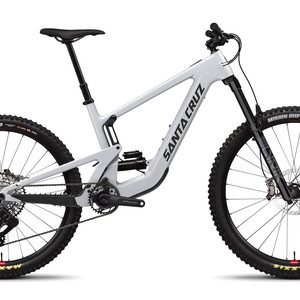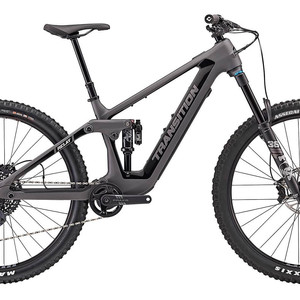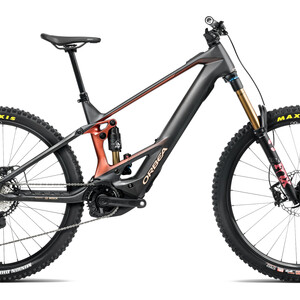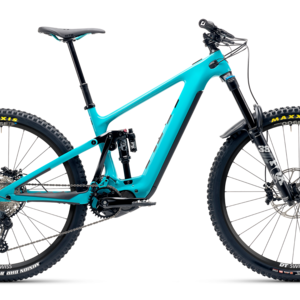2021 Specialized Turbo Levo SL Expert Carbon E-Bike
(discontinued)
| Where To Buy | |||
|---|---|---|---|
Free U.S. shipping on orders over $50, except bikes.
There is a $50 destination fee for bikes. |
Free U.S. shipping on orders over $50, except bikes.
There is a $50 destination fee for bikes. $8,499.99
|
||
Turbo Levo SL Expert Carbon
$8,499.99
|
|||
Free shipping on orders over $50 (continental U.S. only).
International shipping available. Some exclusions apply. |
|||
Free shipping on orders over $50 (continental U.S. only).
International shipping available. Some exclusions apply. |
|||
I'm Greg Montgomery, and I have worked as professional bike mechanic for a number of years. Always passionate, and somewhat obsessive, bikes and their performance have been on my mind as I raced all forms of pedal-powered machines as youngster. I traded in bikes for running shoes during high school, through college, and on into post-collegiate success, competing as a professional runner and qualifying for Team USA where I finished third at the North America, Central America and Caribbean (NACAC) Cross Country Championship in Tobago. Finding my way back into MTB a few years ago, I am now taking my running and fitness success over to competitive mountain bike racing with my eyes set on the Downieville Classic. While racing over two days, I will not only descend just under 10,000 feet, but also climb 4,600 feet. Needless to say, in order to give it my best shot, my fitness and bike-handling skills will need to be on another level.
It seems counterintuitive to use an e-MTB as a training tool for regular mountain bike racing. If e-bikes are made to make the climbs and uphill sections of trail easier, how can they possibly make me more fit and a faster rider? Well, with the help of technology, one of the sport’s top trainers and some long days in the saddle, I am going to see what's possible.
Mountain Bike Race Training Strategy with Blueprint Coach, Joel Harwood
I have a lot of training knowledge when it pertains to running. But, running and mountain bike racing are distinctly different. Human physiology is a constant, but how it is utilized in each sport requires specific stimuli. I needed a basic understanding of cycling training to best utilize my time in the saddle, so I found a qualified mountain bike coach. Joel Harwood is the owner and coach at Blueprint Athlete Development in Squamish, British Columbia. He has worked with many of Canada's top athletes like the Canadian Junior DH team, Finn Iles, Jesse Melamed, Remi Gauvin, Miranda Miller and more. He's also tested products for Vital MTB.

Using Zoom, I was able to consult with Joel. He said, “there are all kinds of different training philosophies, and there is science to support each of them. The three training philosophies are Sweet Spot Training (medium intensity most of the time), High-Intensity Interval Training (short, maximal efforts), and Polarized Training. Polarized training spends most of the time, 70-80%, at low intensity, and then 20-30% at higher intensity. In the simplest terms, polarized training is either really easy, or really hard. Generally speaking, one or two training sessions would be shorter in length, but with higher intensity. The remainder would be low intensity.



“Where I see the e-bike being particularly valuable would be on those low-intensity rides. On an ‘acoustic' bike (non-motorized bicycle), you don’t cover any ground. You are basically only riding as fast as you can nose-breath. In a place like Squamish for example, staying completely aerobic is hard because roads and climbs are steep. If you're staying aerobic, you're 32x51 and nursing it... which sucks because you actually descend very little within a given ride. On an e-bike at full power assist, you could do the same training session but descend 400% more vertical and (in theory) have way more mileage to work on your descending skills. If you used this logic for an entire off-season, the e-bike athlete would accumulate significantly more descending miles than an 'acoustic' biker. That said, if you're racing on acoustic bikes, there's the obvious disadvantage of the two bikes riding quite differently, which is probably worth noting in your article. If money were no object, I'd have one [e-MTB]. For what it's worth, I use this same logic to justify riding moto.”
I was really pleased from what I got out of the conversation. The use of a polarized training plan was a familiar concept, but the sheer volume of aerobic work in conjunction with the descending volume is exciting.
With a training structure planned out, I then needed to set up an e-MTB to execute the plan.
The Bikes - e-MTB and MTB

Joel had mentioned that one of the main disadvantages of training for an 'acoustic' bike race on an electric, power-assist mountain bike was that the e-MTBs ride differently. The weight of an e-bike impacts performance on the trail, for better or worse, when compared to a regular mountain bike. The riding skills are obviously similar, like with a moto, but they are not analogous. In an effort to eliminate that flaw, and to get the closest match to my preferred race platform for Downieville, the 2021 Specialized Stumpjumper S-Works, I chose the 2021 Specialized Turbo Levo SL Expert Carbon.

The Levo SL has FOX 36 up front while the Stumpjumper has a 34, so it's not a perfect, straight-across comparison when it comes to sturdiness of componentry, but the complete package of the Levo SL as a training tool is more than optimal for my training plan. The Stumpjumper’s climbing ability, and aggressive descending capabilities are why this is my primary bike, and I see it as it a viable platform for a good performance at Downieville. The geometry of the Levo SL and the Stumpjumper look very different on paper. With a 66-degree head angle and 455mm reach in size large, the Levo SL would be considered...conservative. The e-bike's extra weight and low distribution of that weight, provides a similar on-trail feel to a bike with updated angles like the new Stumpjumper. It also helps that the Levo SL is one of the lightest e-bikes available. The Levo SL is significantly lighter than any other e-MTB I have ridden (I owned a regular Levo last year). Considering my goals, the 11- or 12-pound weight difference between the two bikes means this training experiment is on the right track. Bonus: the Levo SL is just fun to ride.
Training Technology, Devices, Apps
Along with the bike, I used Specialized the Mission Control app, a Wahoo heart rate monitor, Wahoo Element Bolt computer, TrainerRoad training system and the BLEvo app. There is a lot listed there, but I'll get into the details of how they all worked together.



e-MTB Workouts and Training Program
I broke my wrist near the end of summer 2020. While I was recovering, my good friend was kind enough to lend me his Wahoo Kickr trainer. Along with the trainer, I signed up to TrainerRoad for workouts. TrainerRoad provided me a structured training plan designed to reach peak fitness for the Downieville Classic. The program itself is well-thought out and insightful. I learned a lot about cycling training as I pedaled my heart out. After my wrist improved, I wanted to transfer this knowledge and these workouts to the trails.
Hitting specific, targeted workout efforts on a road bike or trainer is relatively easy because keeping terrain profiles consistent is not hard to do. Road biking on flat roads have very few variables that would affect the power output of the rider. A trainer? Well, just program your ride and get pedaling. There no surprise hills around the corner to spike your heart rate if you choose. This is where the e-bike comes in and gets really exciting. I can upload workouts from TrainerRoad onto the display of the Wahoo Element Bolt computer. By manually actuating the motor on the Levo SL, I can mitigate the terrain's impact on my output. For example, there are plenty of roads and moto trails to ride around the Boise, Idaho, area where I live and train. The problem is that these rides require far more energy output from the rider than would ever be specified in a structured training regimen. From the ‘rest’ to ‘interval’ portions of the work, I can use the Levo SL's motor, as well as its built in power meter. That's right, the built-in power meter. No aftermarket power meter required. The Levo SL's motor and power meter assisted me with staying consistent and hitting the my workout's effort range (in watts). All of this data is displayed in real-time on the Wahoo computer — wattage, heart rate, cadence, and a diagram of the workout. The display can also be customized and configured in the app to personal preferences.

Flatten the Climbs
Understanding that the Levo SL can essentially flatten out the climbs, keeping me in a preferred training zone, it was time to put the experiment into action.
Firstly, I ran my idea by coach Joel. He hadn’t been to Boise, so it was hard to accurately convey my process in our brief discussion. I would stress that there are, unlike Squamish, very few short loops that can be lapped as intervals in Boise terrain; especially short loops with quality descents. The trails that I spend most of my time on include massive climbs. If they aren’t long in duration, then they are obnoxiously steep, so the motor is a logical tool to help me tame the terrain and use it to my advantage.
I headed straight up a local moto trail where e-bikes are allowed, called Trail 4 (or 8th street moto trail), which was used in Vital's e-MTB Test Sessions. I had a downloaded workout that included a series of nine intervals with corresponding rest periouds. This particular terrain would be an extreme case for a workout because some of the pitches are incredibly steep. Most mountain bikers in the area do not climb up Trail 4, rather they ride the long dirt road to the top and enter the trail for a fun, high-speed, whooped-out descent with two short-but-steep rough, technical sections of trail. This descent is the closest a rider in the area can get to some prolonged DH- or enduro-level skill and speed training without heading a few hours up into the mountains.

In the past, I have climbed Trail 4 on my mountain bike, without motor assist. It's a fun fitness and technical skills challenge. Pushing between 600-800 watts just to get up many of these climbs, the term "punchy" should be swapped to "knock-blow-from-Mike-Tyson" when going up sections of Trail 4 without a motor. With this extreme test, my goal was to see if the e-bike could "flatten" the terrain, so I could keep myself near 350 watts effort for interval periods and less than180 watts for rest periods.
How did the climb experiment on the Levo SL work? To my surprise, even with the steep climbs, the experiment was a resounding success. I was able to achieve from the work out precisely what I was hoping. I managed to climb the grunts and whoops of Trail 4 with a minimal and controlled effort that was within the range of my training. Then, the fun and skill-building began. I turned around and descended 2,400 feet, through drifting turns, rain ruts, moto-bermed corners and suspension-flexing g-outs for my ‘cool down.’ There is no way this ride would have been possible, on that trail, with workout goals in mind on a motor-free mountain bike. Afterward, I realized I this concept will easily transfer to the expanse of e-bike-legal trails in the surrounding area. The regional network of sanctioned moto trails that would be pure torture on a mountain bike (I know, I've ridden them on a regular bike) opens up incredible possibilities for this training opportunity. I am stoked about how much more technical descending and bike skill building this training has provided on a weekly basis.
Rest Days and Automated Motor Control - Smart Levo SL
On a polarized training plan, the bulk of weekly volume is spent riding at a very easy effort. Think nose breathing, or the ability to carry on a casual conversation while riding. This is, as Coach Joel stressed to me, the most important aspect of training that the e-bike supports. Keeping within that easy effort range on a mountain bike would result in a fraction of the descending and skill-building time. While it's easy enough stick to a specified wattage effort by manually altering the motor’s output through the bar-mounted control, I decided that I would prefer to reduce mental energy and just ride. I investigated options for automatic motor control based on my body's output.

Originally, I was using Specialized's Mission Control app and its Smart Control feature paired with the Wahoo heart rate monitor. This helped me stay in an easy, aerobic effort. The problem was the system's exclusive reliance on heart rate. Heart rate is practical data, but has limitations. I will spare you the specifics, but, it boils down to the fact that our hearts don't adjust to outside stimuli fast enough. It can take tens of seconds before heart rate elevates in response to a dramatic increase in effort. Ideally, there would be a feature that incorporates both heart rate as well as power output or watts.
Enter the BLEvo app. It incorporates the components of the Mission Control app, in addition to what I was wanting. BLEvo let's me set my preferred heart rate range, as well as power range. What that means is that the e-bike will automatically provide more assistance in steeper gradients than on sections that are more gradual. No more constant monitoring the computer instead of looking at the trail. No more manually increasing or decreasing motor power with my finger via the bar-mounted control. I'm now hands-free and focused on the trail or chatting with friends. On easy days, I just set the parameters, put my phone in my pocket, and carry on. The addition of power data results in a much more responsive and effective ride. There is a lot more that BLEvo app can do, but that would be an entire article in itself. If I podium at Downvielle, I'll write it.

Technology Isn't Perfect...Yet
Workouts on the e-bike did not come without faults. Either the wattage display or my input into the bike was only updated to the system every three seconds. On consistent, smooth gradients and easy days this isn't much to worry about, but on a trail with undulating terrain, the lag time between each wattage reading left me floating above or below my target range on occasion. Trail 4 was an extreme case, but it highlighted the issue. A positive spin on the problem is that I have a great way to perfect my pedaling cadence technique because the workaround of lag time is to keep a fast, smooth cadence. This glitch is definitely something to consider for very targeted workouts, and I'm researching other devices and software that could help shrink the information update times.
Conclusion
I'm claiming mission accomplished. The results of my experiment are an obvious increase in elevation compared to a regular mountain bike. In turn, I achieved a massive increase in the volume of descent skills practice. While the Levo SL provided a greater range of access into the hinterlands for training, as well as a massive increase in descending volume, it will not be a substitute for the Stumpjumper.

This is not an article designed to downgrade mountain bikes in comparison to e-MTBs. Nothing! I repeat, nothing will replace a mountain bike in my stable. My goal with this project was to mitigate my weaknesses in skill and progress my riding. After years of running, I have recently changed gears with an obsession for improving my descending skills on a mountain bike. That goal is only possible with on-trail experience. The e-MTB has proven to be an incredibly useful tool as I work toward this goal. Will I use the Levo SL for all of my workouts? No. Will I use it for all of my easy days? No. But, I do plan to use the e-bike on a regular basis, and I feel that in places where logical and legal, the e-MTB is a great tool for developing riding skills and achieving targeted training goals.
If you have any questions, feel free to leave them in the comments!

Vital Test Sessions - 4 eMTBs Reviewed Head-to-Head
Specifications
Optional: Specialized SL1-160 external range-extender battery with cable, 160 Wh
Length: 40mm (SM/MD), 50mm (LG/XL)
Length: 165mm (SM/MD), 170mm (LG/XL)
Rear: Specialized Eliminator, GRID TRAIL casing, GRIPTON compound, 2Bliss ready, 29" x 2.3"
Width: 155mm (SM), 143mm (MD/LG/XL)
Drop: 125mm (SM), 150mm (MD/LG), 170mm (XL)
- Internal cable routing
- Includes custom battery charger, 48V system with SL system charger plug
| Where To Buy | |||
|---|---|---|---|
Free U.S. shipping on orders over $50, except bikes.
There is a $50 destination fee for bikes. |
Free U.S. shipping on orders over $50, except bikes.
There is a $50 destination fee for bikes. $8,499.99
|
||
Turbo Levo SL Expert Carbon
$8,499.99
|
|||
Free shipping on orders over $50 (continental U.S. only).
International shipping available. Some exclusions apply. |
|||
Free shipping on orders over $50 (continental U.S. only).
International shipping available. Some exclusions apply. |
|||



































30 comments
Post a reply to: Using a Specialized Turbo Levo SL e-Bike to Train for Mountain B